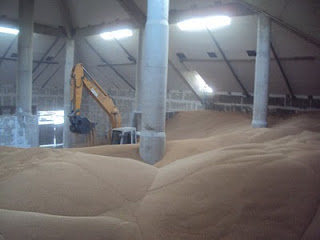

Home ||| Bulk Cargo ||| Planning ||| Care ||| Safety||| Self unloaders
Terminology Used in the Carriage of Grain in Bulk Carrier

The term grain includes wheat, maize (corn), oats, rye, barley, rice, pulses, seeds and their processed forms which may behave in a similar way to grain in its natural state. The loading and carriage of grain cargoes is governed by the International Convention on Safety of Life at Sea (SOLAS), Chapter VI, Part C, supplemented by the International Code for the Safe Carriage of Grain in Bulk (International Grain Code, 1991).
Part A of the IGC lays down specific requirements relating to stability information, stability requirements, the stowage of bulk grain, grain fittings, divisions (i.e. shifting boards) and their associated equipment together with strict regulations if a saucer, bundling, overstowing, strapping or lashing, or wire mesh are being used as a means to eliminate heeling moments in a partially filled compartment.
The satisfactory loading, carriage and delivery of grain requires constant attention from ships' staff with consequent knowledge of the above regulations and the characteristics of the particular cargo loaded.
The following definitions are from the IMO International Grain Code
The term grain covers wheat, maize (corn), oats, rye, barley, rice, pulses, seeds and processed forms thereof, whose behaviour is similar to that of grain in its natural state.
The term filled compartment, trimmed, refers to any cargo space in which, after loading and trimming as required under A 10.2, the bulk grain is at its highest possible level.
The term filled compartment, untrimmed, refers to a cargo space which is filled to the maximum extent possible in way of the hatch opening but which has not been trimmed outside the periphery of the hatch opening either by the provisions of A 10.3.1 for all ships or A 10.3.2 for specially suitable compartments.
The term partly filled compartment refers to any cargo space wherein the bulk grain is not loaded in the manner prescribed in A 2.2 or A 2.3.
The term angle of flooding (1) means the angle of heel at which openings in the hull, superstructures or deckhouses, which cannot be closed weathertight, immerse. In applying this definition, small openings through which progressive flooding cannot take place need not be considered as open.

Fig: bulk wheat
The term stowage factor, for the purposes of calculating the grain heeling moment caused by a shift of grain, means the volume per unit weight of the cargo as attested by the loading facility, i.e. no allowance shall be made for lost space when the cargo space is nominally filled.
The term specially suitable compartment refers to a cargo space which is constructed with at least two vertical or sloping, longitudinal, grain- tight divisions which are coincident with the hatch side girders or are so positioned as to limit the effect of any transverse shift of grain. If sloping, the divisions shall have an inclination of not less than 30° to the horizontal.
The Document of Authorisation certifies that a ship is capable of loading grain in accordance with the requirements of the International Grain Code.
Grain handling more guidelines
-
Hazards and safety precautions for grain cargo
-
Grain loading preparation
-
Presence of contaminants & handling other defective grain
-
Grain terminology from IMO grain code
-
What is international grain code and why it is used in bulk carriers ?
Related Information
Loading, carrying and discharging of bulk coal
Safety precautions for loading and carriage of iron ores
Hazards and safety precautions for grain cargo
Monitoring cargo operation safety checks in a bulk terminal
Our detail pages illustrated many safety aspects of Bulk carrier
Home page |||Bulk carrier types ||| Handling of bulk coal |||Cargo planning ||| Carriage of grain |||Risk of iron ores |||Self unloading bulk carriers |||Care of cargo & vessel |||Cargoes that may liquefy |||Suitability of ships |||Terminal guideline |||Hold cleaning |||Cargo cranes |||Ballast handling procedure |||Bulk carrier safety |||Fire fighting systems |||Bulk carrier General arrangement
Top articles
- Cargo information required by ship master prior handling bulk cargo
- Care of cargo during loading- Trimming pours
- Checklist for confirming stabilty and hull stress prior loading
- Cargo loading agreement between ship and terminal
- Bulk carrier loading manual
- Handling of deballasting (ship duties) during high loading rate
- Cargo and ballast handling guide
- Responsibility of ship during cargo operation
- Shipboard hazards & bulk carriers safety guideline
- Asymmetric cargo and ballast distribution for bulk carriers
- Limitations on exceeding load lines
- Risk of deviation from the loading limitations
- Cargo handling guidance for deck officers

Operation of sea going bulk carriers involved numerous hazards . Careful planning and exercising due caution for all critical shipboard matters are important . This site is a quick reference to international shipping community with guidance and information on the loading and discharging of modern bulk carriers so as to remain within the limitations as specified by the classification society.
It is vital to reduce the likelihood of over-stressing the ship's structure and also complying with all essential safety measures for a safe passage at sea. Our detail pages contain various bulk carrier related topics that might be useful for people working on board and those who working ashore in the terminal. For any remarks please Contact us
Copyright © 2010 bulkcarrierguide.com All rights reserved.
Although every effort have been taken to improve the accuracy of content provided the publisher of this website cannot gaurantee for errors. Disclaimer Privacy policy Home page


